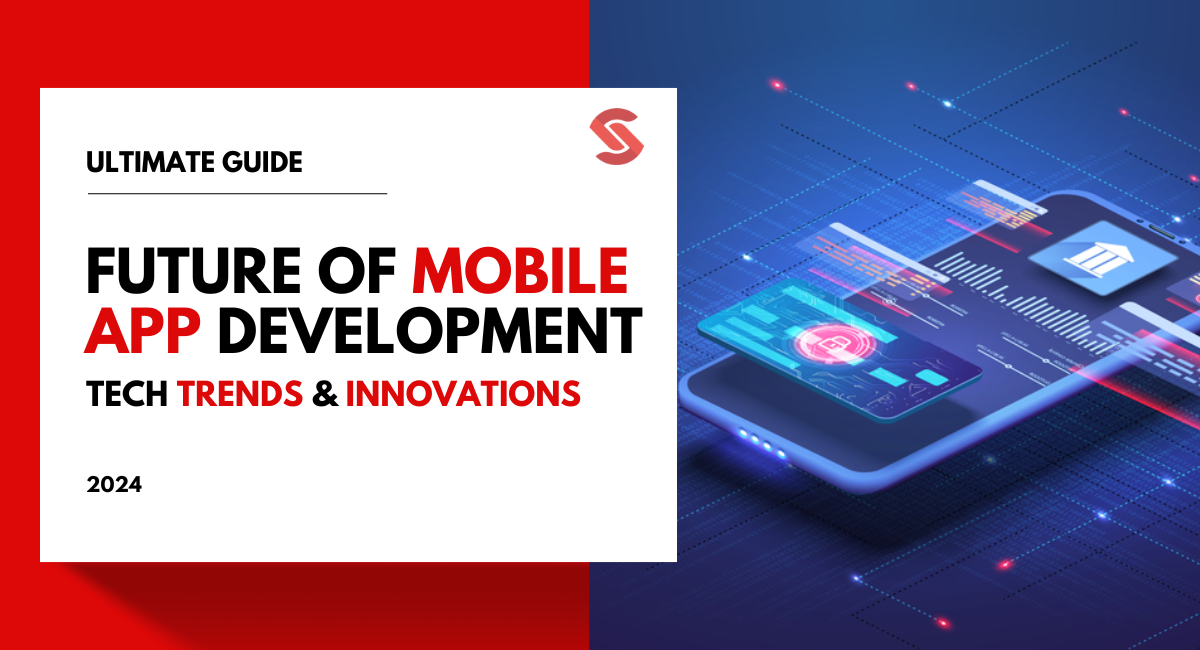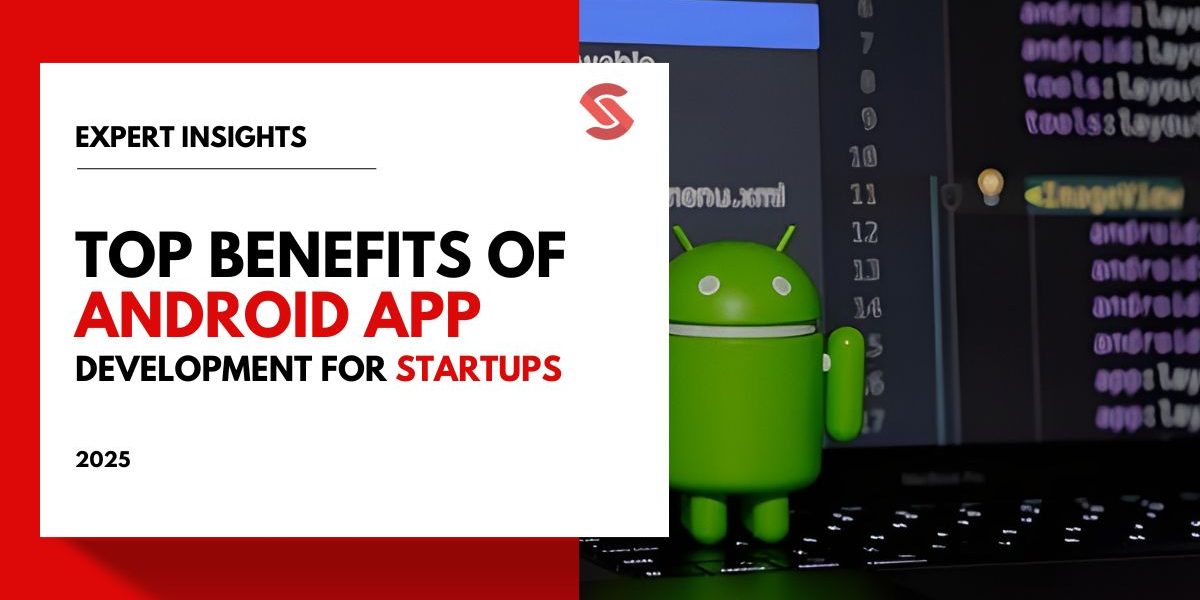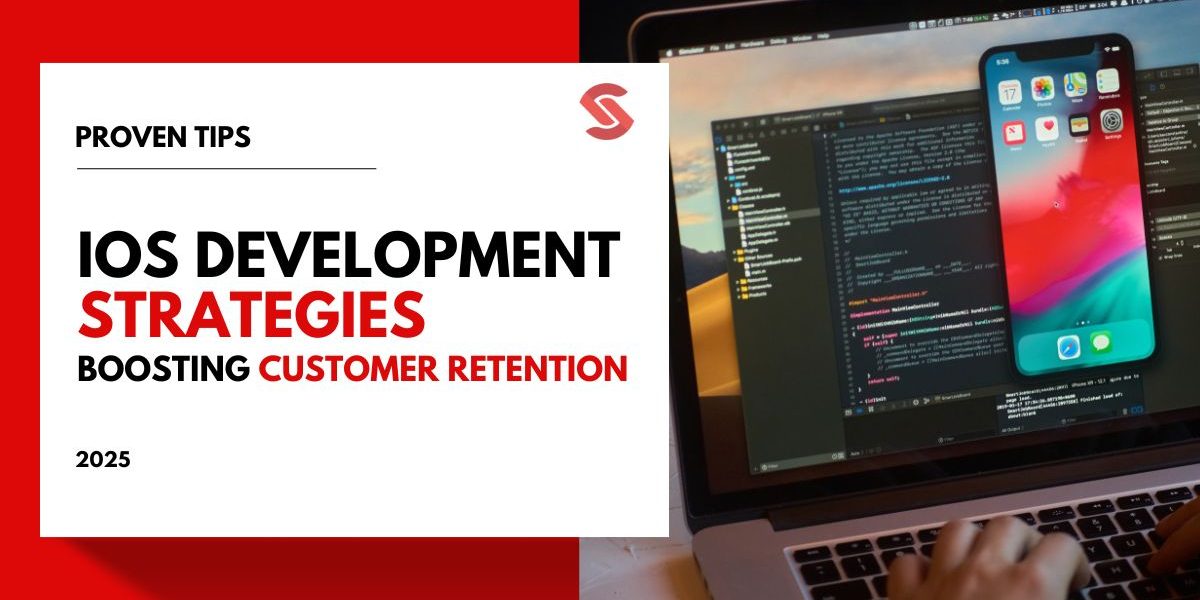Mobile apps have become an important part of our daily lives, making everything from ordering food to connecting with friends just a few taps away. With millions of apps vying for user attention, developers are driven to innovate and enhance the user experience.
As technology evolves, breakthroughs like AI, machine learning, 5G, and no-code development are transforming the mobile app market. AI alone is expected to reach a market value of $126 billion by 2025, showing its impact on app development. In this blog, we’ll explore emerging trends and how they can help businesses grow.
Integration of AI and Machine Learning
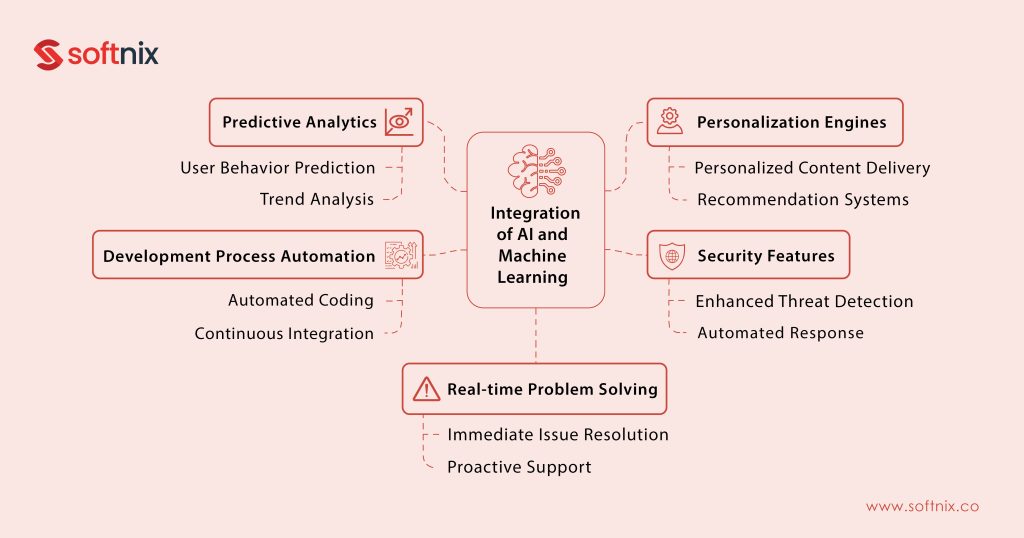
AI and machine learning are transforming how mobile apps interact with users, enabling apps to provide more personalized, seamless experiences. These technologies allow apps to predict user preferences, automate routine processes, and deliver highly relevant content.
As a result, businesses can offer users a unique, engaging experience that feels intuitive and effortless. By making apps smarter and more responsive, AI and machine learning help businesses create better user experiences, ultimately improving both engagement and customer satisfaction.
Predictive Analytics in User Behavior
Predictive analytics helps apps forecast user behavior by analyzing past interactions and identifying patterns. According to Gartner, “By 2022, 40% of mobile apps will leverage predictive analytics to enhance user experiences.”
By understanding user behavior before it happens, apps can not only anticipate needs but also recommend actions or products that keep users engaged, leading to a smoother, more personalized experience.
AI-driven Personalization Engines
Personalization engines powered by AI take user experience to the next level. By continuously analyzing user data and behaviors, these engines deliver tailored content, recommendations, and offers that adjust in real time.
As AI learns from users over time, the level of personalization deepens, creating a unique experience for each individual, which boosts customer loyalty and long-term retention, ultimately contributing to business growth.
Machine Learning for Enhanced Security Features
Using machine learning enhances security in mobile apps by identifying potential threats and unusual user activities in real-time. This technology helps apps become more proactive in preventing cyberattacks and protecting sensitive data. As the app learns and adapts over time, security measures become smarter and more effective.
- Monitors user behavior to detect suspicious activity early
- Continuously refines security protocols based on new data
- Strengthens authentication systems to prevent unauthorized access
Automation of Development Processes
Automating development processes not only accelerates app production but also improves consistency and accuracy by reducing human intervention in repetitive tasks like coding, testing, and deployment.
Automation allows teams to streamline workflows, ensuring faster iterations and minimizing errors. Ultimately, automation tools lead to faster project delivery, improved code quality, and more efficient resource management, resulting in higher-quality apps.
Real-time Problem Solving with AI
AI enhances real-time problem-solving by quickly identifying and resolving issues as they occur, whether it’s debugging, optimizing app performance, or handling user requests. AI can analyze vast datasets instantly, offering precise solutions in seconds.
This capability helps maintain app stability, reduce downtime, and deliver a better user experience. By continually learning and adapting, AI-driven systems ensure that problems are addressed more efficiently, allowing businesses to provide smoother, uninterrupted service.
The Rise of Augmented and Virtual Reality Apps
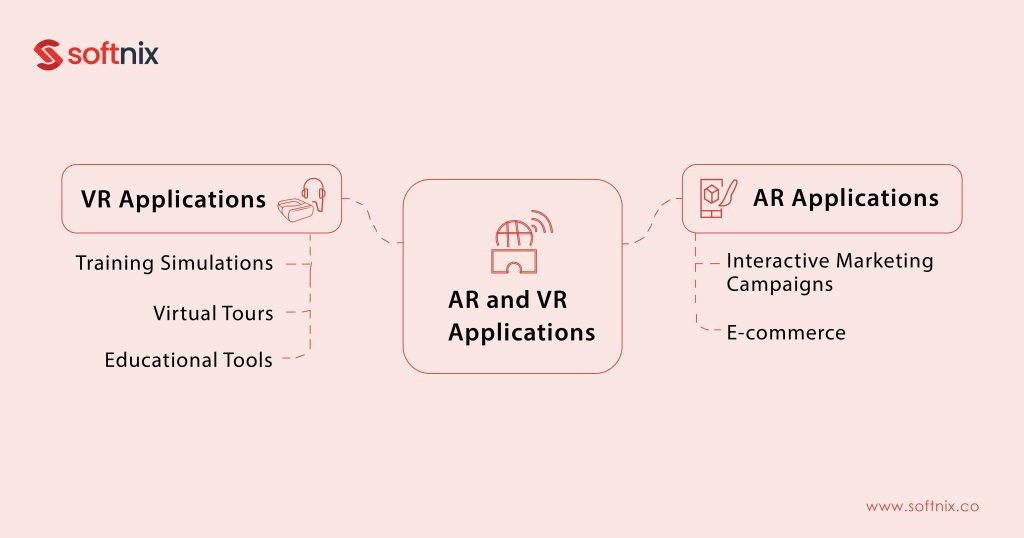
Augmented Reality (AR) and Virtual Reality (VR) are expanding beyond gaming, reshaping industries like retail, real estate, and education with immersive user experiences. AR lets users try products virtually, while VR creates fully immersive environments for learning and virtual property tours.
Successful apps like IKEA Place and Google Expeditions demonstrate this potential. According to Statista, the AR/VR market is projected to reach $296.9 billion by 2024, reflecting its growing influence in mobile development.
AR for Interactive Marketing Campaigns
Augmented reality is transforming marketing campaigns by creating engaging, interactive experiences for users. AR allows brands to bring products to life, offering customers immersive ways to explore and interact with content. This level of engagement helps brands stand out, making campaigns more memorable and impactful.
- Allows users to visualize products in real-time
- Enhances customer interaction by blending the digital and physical worlds
- Boosts engagement rates, driving more effective and memorable campaigns
VR Training Simulations
Virtual reality is revolutionizing industries like healthcare, aviation, and manufacturing by transforming the way employees are trained. VR simulations allow workers to engage in hands-on learning without real-world risks.
For example, surgeons can practice complex procedures or pilots can rehearse emergency scenarios, all in a controlled virtual environment. This not only improves skill retention but also reduces training costs and risks associated with traditional methods.
Real Estate Virtual Tours
The real estate industry is being reshaped by virtual reality, which allows buyers to explore properties from anywhere in the world. VR tours provide an immersive experience, enabling potential buyers to visualize properties as if they were physically present.
With VR, real estate agents can offer detailed property views around the clock, changing how properties are showcased and sold, ultimately streamlining the buying process.
AR in E-commerce
Augmented reality is transforming e-commerce by bridging the gap between online and physical shopping. AR allows customers to interact with products before purchasing, such as virtually trying on clothes or seeing how furniture looks in their homes.
This technology increases buyer confidence, reduces product returns, and boosts customer satisfaction. By offering a more interactive and personalized shopping experience, AR is helping businesses stay ahead of the competition and driving growth in the online retail space.
Educational Tools Using VR
Virtual reality is revolutionizing education by providing immersive environments where students can engage with subjects in a more interactive way. Instead of reading about a historical event or scientific concept, students can experience it firsthand through VR. This leads to deeper understanding, better retention, and a more engaging learning experience.
- Simplifies complex topics through immersive exploration
- Creates interactive, hands-on learning opportunities
- Enhances student engagement and information retention
Blockchain Technology for Mobile Apps
Blockchain technology transforms mobile app development by offering enhanced security, transparency, and efficient data management. Especially in apps involving transactions, such as financial or e-commerce platforms, blockchain provides a decentralized ledger that protects sensitive information and prevents fraud.
With the rise of cryptocurrency and secure transactions, blockchain is becoming a critical component in mobile app security and data integrity, making it a powerful tool for developers to integrate into transaction-heavy apps.
Enhancing Mobile App Security
Mobile apps face constant cyberattack threats, and blockchain technology offers a solution by decentralizing data and making it nearly impossible for hackers to alter.
Blockchain strengthens mobile app security by encrypting data, providing tamper-proof records, and ensuring user information remains safe from breaches, which is crucial for sensitive apps like banking and healthcare.
Blockchain for Transparent Supply Chains
Blockchain enhances transparency in supply chains by recording every transaction or product movement in a decentralized ledger. Mobile apps using blockchain can track goods from production to delivery, providing real-time updates.
This level of transparency ensures trust among all parties, reduces fraud, and improves efficiency in logistics.
Smart Contracts in Mobile Apps
Smart contracts allow mobile apps to automate agreements, ensuring that transactions execute only when predefined conditions are met.
These self-executing contracts reduce the need for intermediaries, increasing efficiency and lowering costs.
Smart contracts in mobile apps, especially in finance and real estate, offer users greater security and transparency.
Decentralized Mobile Apps (DApps)
Decentralized mobile apps (DApps) run on blockchain networks, offering greater security, transparency, and user control.
Unlike traditional apps, DApps eliminate the need for a central authority, reducing the risk of data breaches and censorship.
Cryptocurrency Wallets and Exchanges
Managing and trading digital assets is facilitated through wallets and exchanges. Wallets securely store cryptocurrencies, while exchanges allow users to buy, sell, or trade them. These platforms focus on providing secure transactions and transparency, ensuring users can safely navigate the growing world of digital currencies.
- Wallets safeguard cryptocurrencies with private keys
- Exchanges allow seamless buying, selling, and trading
- Security measures protect against cyber threats and fraud
The Evolution of the Internet of Things (IoT) in Mobile Apps
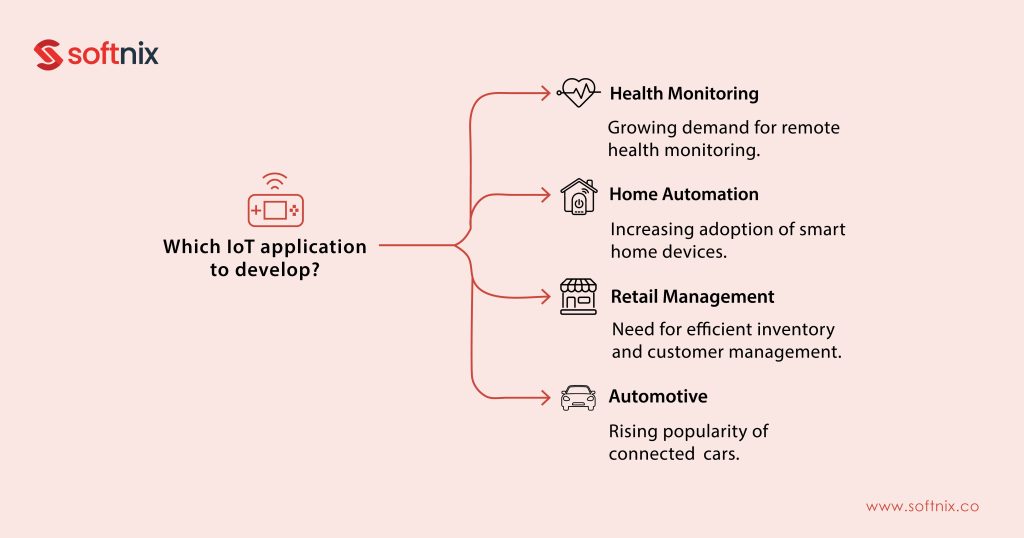
The integration of IoT technology in mobile apps is transforming how we interact with smart devices, from home automation to health monitoring. IoT enhances connectivity and real-time data access.
According to McKinsey, the economic value generated by IoT could reach $12.6 trillion globally by 2030, highlighting the increasing role of IoT-enabled mobile apps in driving efficiency and enhancing user experiences across various industries.
Health Monitoring Apps
Health monitoring apps are revolutionizing personal healthcare by enabling users to track key metrics like heart rate, sleep patterns, and fitness levels in real-time.
These apps sync with wearable devices to provide continuous data and insights, helping users maintain their health and well-being.
As per Grand View Research, the global mobile health (mHealth) market is expected to reach $158.3 billion by 2030, growing at a compound annual growth rate (CAGR) of 14.1%.
Home Automation Controls
Home automation apps give users the ability to manage smart devices such as lights, security systems, and appliances, from anywhere, offering convenience and enhanced control over their environment.
These apps also improve energy efficiency by allowing users to automate and monitor usage remotely. Chris Anderson, a technology expert, notes, “Home automation is no longer a luxury, it’s becoming a necessity for modern living.
IoT for Retail Management
Internet of Things (IoT) technology is transforming retail management by connecting smart devices and systems to optimize operations. It helps streamline inventory tracking, monitor customer behavior, and automate stock management. This leads to better decision-making and enhances the overall shopping experience.
- Automates inventory management
- Tracks customer movements in-store for better layouts
- Optimizes supply chain and stock levels
These benefits improve efficiency, reduce costs, and offer personalized experiences to customers, helping retailers stay competitive in a rapidly evolving market.
Automotive Apps Connected with IoT
IoT technology is driving innovation in automotive apps, allowing vehicles to connect with mobile devices for real-time data on performance, maintenance alerts, and navigation.
IoT-connected apps enable remote vehicle control, fuel efficiency monitoring, and even predictive maintenance.
These features improve safety, and convenience, and reduce costs by keeping vehicles in optimal condition through real-time updates and proactive alerts.
Agricultural Apps Using IoT
IoT-powered agricultural apps are helping farmers optimize crop management by providing real-time data on soil health, moisture levels, and weather conditions.
These apps allow for precise monitoring, automated irrigation systems, and improved crop yield predictions.
This technology leads to better resource management, increased efficiency, and higher productivity, empowering farmers to make data-driven decisions that boost profitability.
Mobile App Development for Foldable Devices
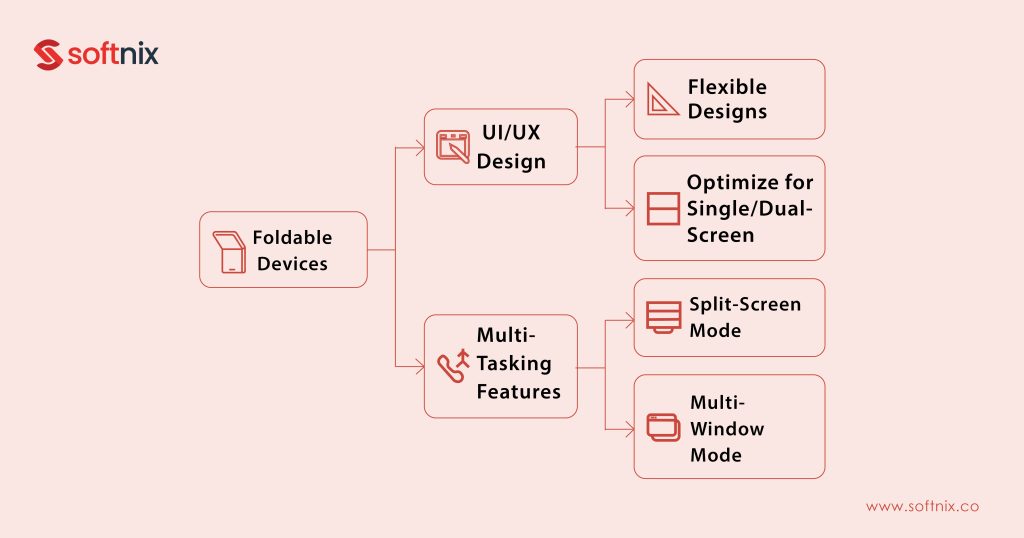
Foldable devices are changing mobile app development, presenting new design challenges and opportunities. Developers must create flexible UI/UX designs that adapt smoothly to different screen sizes and folding modes for a consistent user experience.
Multi-window functionality in foldable devices allows users to run multiple apps at once, boosting productivity and multitasking. As foldable devices become more popular, developers must innovate and optimize apps to fully utilize this technology, delivering efficient experiences across different use cases.
Adapting UI/UX for Foldable Screens
Designing UI/UX for foldable screens involves creating interfaces that transition smoothly between folded and unfolded modes. This ensures a consistent experience as screen sizes change, keeping the app intuitive and functional.
Additionally, developers should optimize the app for single and dual-screen usage, ensuring flexibility across foldable devices to enhance user satisfaction.
Multi-Tasking Features for Enhanced Productivity
Foldable devices enable users to multi-task by running multiple apps simultaneously. Developers must ensure their apps function well in split-screen and multi-window modes.
These capabilities help boost productivity by allowing users to switch tasks effortlessly, making the app more efficient for both personal and professional use.
Best Practices of Development for Foldable Devices
Developing apps for foldable devices involves focusing on adaptable design and functionality. Developers should ensure apps transition smoothly between different screen modes while maintaining performance and user experience. Following best practices helps create apps that work easily across various foldable devices.
- Optimize for multi-window and split-screen use
- Design flexible layouts that adjust to different screen sizes
- Test thoroughly on real devices for performance and usability
- Ensure smooth transitions between folded and unfolded modes
Final Thoughts: Why Staying Ahead Matters
Keeping up with new technology is important for businesses to stay competitive. Using emerging technologies like custom mobile apps can make a big difference, helping companies improve their services and stand out from the crowd.
Falling behind could mean losing opportunities while staying ahead drives growth and success. Our mobile app development services are here to help you embrace these innovations and stay competitive.
Reach out to learn how we can tailor these technologies to fit your business and help it thrive.
FAQs
1. What are the key emerging technologies in mobile app development?
Key emerging technologies include AI, IoT, machine learning, blockchain, augmented reality (AR), virtual reality (VR), and foldable devices. These technologies are transforming app functionality, enhancing user experiences, and enabling new features such as personalized content, seamless multitasking, and improved security.
2. How is AI transforming mobile app development?
AI enhances mobile apps by enabling features like personalized recommendations, voice assistants, and intelligent automation. It helps improve user engagement by analyzing behavior patterns and delivering content tailored to individual preferences. AI-driven apps can also automate processes, improving efficiency for both users and businesses.
3. What is the role of IoT in mobile apps?
IoT connects mobile apps to smart devices, enabling real-time monitoring, control, and data collection. This is especially useful for industries like healthcare, home automation, and retail. IoT integration improves convenience, offering seamless experiences by allowing users to manage devices through mobile apps.
4. Why are foldable devices important for app developers?
Foldable devices introduce unique design challenges for developers, requiring apps to be adaptable across multiple screen sizes and modes. These devices enhance multitasking by allowing users to run multiple apps simultaneously, which calls for optimized UI/UX to provide smooth transitions and user-friendly functionality.
5. How can blockchain technology benefit mobile apps?
Blockchain enhances mobile app security by offering decentralized data storage, reducing the risk of data breaches. It also enables transparency in transaction-heavy apps, such as cryptocurrency wallets or supply chain management, ensuring trust and integrity by keeping records tamper-proof.
6. What are multi-window functionalities in foldable devices?
Multi-window functionalities in foldable devices allow users to run multiple apps side-by-side or in split-screen mode, boosting productivity. Developers must optimize their apps for seamless multitasking, ensuring a smooth user experience when switching between or using multiple apps simultaneously.
7. How can AR and VR technologies improve mobile apps?
AR and VR bring immersive experiences to mobile apps, enhancing sectors like gaming, education, retail, and real estate. AR enables users to visualize products in their environment, while VR creates fully interactive virtual spaces, offering new opportunities for user engagement and creativity.
8. How does machine learning enhance mobile app performance?
Machine learning analyzes user behavior and data to improve app performance through personalized recommendations, predictive analytics, and better decision-making. It allows apps to learn and adapt over time, optimizing functionality and delivering more relevant content to users.
9. What is the impact of 5G on mobile app development?
5G technology enables faster data speeds and low-latency connections, allowing developers to create more responsive, feature-rich apps. It supports real-time experiences, such as live streaming, augmented reality, and IoT integrations, providing users with seamless and immersive interactions.
10. Why is UI/UX adaptation crucial for foldable devices?
UI/UX adaptation is crucial for foldable devices because apps need to provide a consistent and smooth user experience across different screen configurations. As foldable devices shift between single and multi-screen modes, well-designed UI/UX ensures that functionality and aesthetics remain intuitive.
11. What are the benefits of integrating IoT with retail mobile apps?
Integrating IoT with retail mobile apps enhances inventory management, customer engagement, and data collection. IoT devices can track stock levels in real time, personalize the shopping experience based on user behavior, and provide valuable insights to optimize retail operations.
12. Why should businesses invest in emerging mobile technologies?
Investing in emerging mobile technologies allows businesses to stay ahead of market trends, improve user experiences, and enhance operational efficiency. Technologies like AI, IoT, and blockchain offer a competitive advantage by enabling innovation, driving engagement, and meeting evolving customer expectations.

